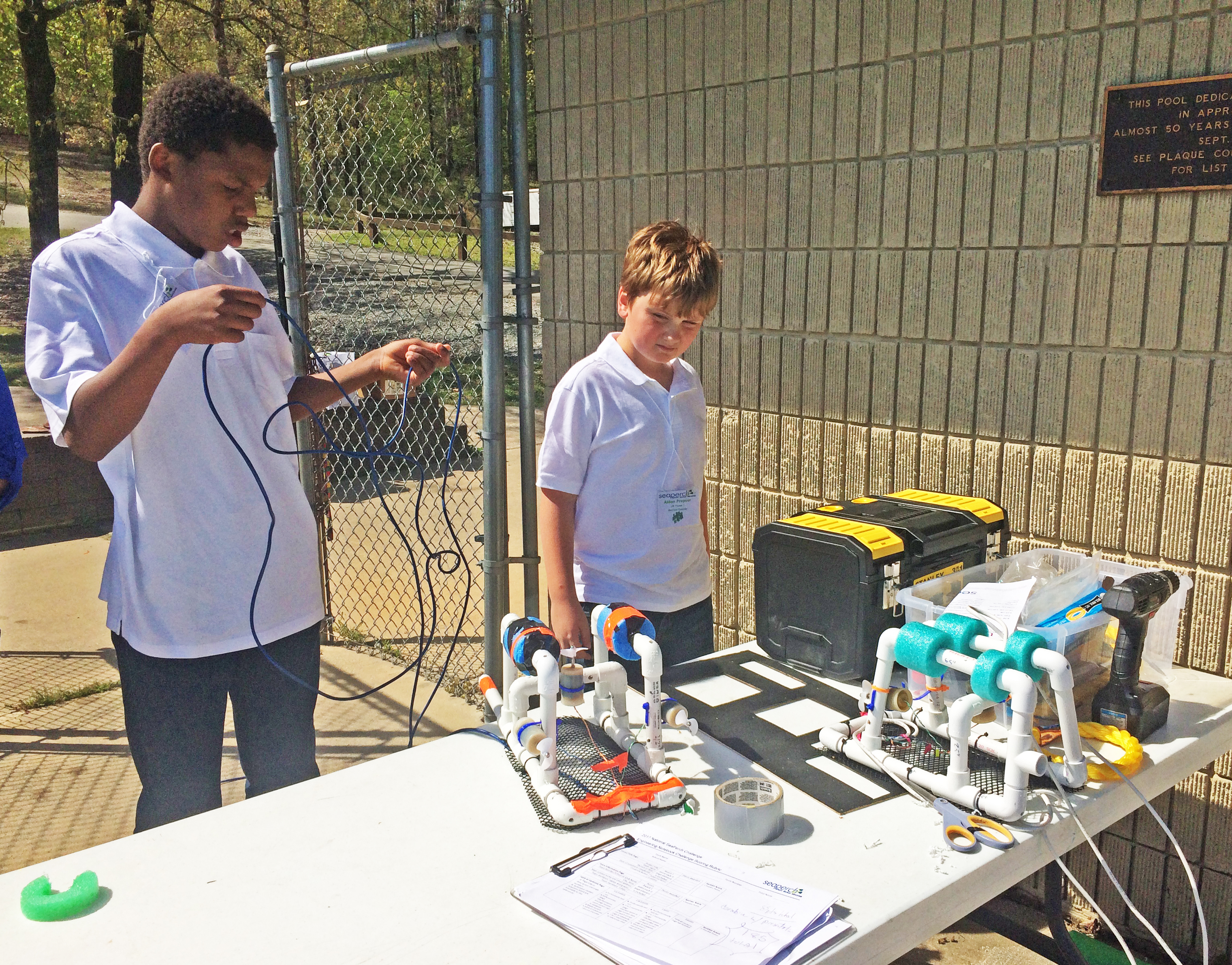Benton, Grant county teams head national 4-H competition with remote-controlled submersibles
May 17, 2017
By Emily Thompson
U of A System Division of Agriculture
Fast Facts:
- STEM fields are fastest growing jobs in U.S., but student performance in these areas is low.
- Arkansas 4-H hands-on activities help increase STEM performance.
- Fourteen 4-H teams compete in state SeaPerch competition.
- Grant, Benton counties to send state-winning teams to nationals, May 19-20.
(640 words)
(Newsrooms – with downloadable art: www.flickr.com/photos/uacescomm/sets/72157680416017681)
Download Word version.
LITTLE ROCK – Seven youths from Grant and Benton counties will be representing Arkansas at the 2017 National SeaPerch Challenge in Atlanta on May 19-20, a competition that puts the emphasis on engineering as each team puts its remotely operated underwater vehicle through its paces.
The junior team is 4H2O from Sheridan Intermediate School, representing Grant County and coached by Brad McGinley, Grant County extension staff chair for the University of Arkansas System Division of Agriculture.
The senior 4-H team is Glitter Girlz Gold from Benton County, coached by Karl and Tamara Kay.

Through SeaPerch, an aquatic engineering program, 4-Her’s are able to build an underwater water remotely operated vehicle, or underwater ROV, out of a kit of easily accessible parts. SeaPerch is one of the science, technology, engineering and mathematics initiatives 4-H uses to help build STEM skills among its youth.
“It’s a true kit,” said Rick Fields, extension 4-H science and curriculum coordinator for the University of Arkansas System Division of Agriculture. “They have to assemble all the parts.”
4-Her’s are given instructions on basic skills they need to build their ROV, like soldering and cutting materials, and then are let loose to begin building. The ROV’s are customizable, letting their designer’s creativity flow.
“4-H subscribes to the experiential learning model,” said Fields. “We’ll give them some background information and then they learn by doing.”
By building the ROVs relatively independently, 4-Her’s learn the engineering design model where engineers are presented with a goal, they build something to achieve that goal and then tweak it so it performs at the level it needs to—a process they documented in their engineering journal, said Fields.
When they get to the Georgia Tech venue, the team will face three contests: the challenge course, the obstacle course and an oral presentation.
In the challenge course, the competitors must get their submersible to retrieve nylon rings and PVC cubes from one platform and deliver and place the rings and cubes on the arms of another platform, all within a specific time period.
For the obstacle course phase, the teams must pilot their submersibles on a roundtrip through a course consisting of five hoops turned at different angles. The competitors won’t know where or how the hoops are positioned until they get to the venue.
The third phase, the oral presentation, is based on the competitors’ engineering notebook. The notebook begins by encouraging youth to solve the problem of how to get involved in SeaPerch; designing a solution to that problem and then doing what it takes to make their submersible the best it can be.
“The notebooks help them approach this as engineers,” Fields said. “They are tasked with documenting all the challenges, obstacles and changes they made to the vehicle.
“And as with professional engineers, they have to go back to the drawing board frequently,” he said. “Motors burn outs, insulation failures, they have to fix things that don’t work.”
After the final tweaks were made to ensure that the underwater ROVs are performing at their very best, 14 county 4-H teams made to the trek to the C.A. Vines 4-H Center pool on April 9, competing for a spot at the nationals.
Needed: STEM skills
According to the United States Bureau of Labor Statistics, the STEM fields are the fastest growing occupations in the country. However, student proficiency in these fields in Arkansas is low.
The National Assessment of Educational Progress is the largest uniform, continuing assessment that measures students’ knowledge of different subjects and serves as a yardstick to document student progress overtime. In 2011, 37 percent of Arkansas fourth graders scored proficient in math and 29 percent in science. Those scores drop in middle school, with 29 percent of eighth graders reaching proficient in math and 26 percent in science.
For more information about 4-H or the SeaPerch program in your county, contact your local county extension agent. To find your local county agent, visit, https://www.uaex.uada.edu/counties/.
About the Division of Agriculture
The University of Arkansas System Division of Agriculture’s mission is to strengthen agriculture, communities, and families by connecting trusted research to the adoption of best practices. Through the Agricultural Experiment Station and the Cooperative Extension Service, the Division of Agriculture conducts research and extension work within the nation’s historic land grant education system.
Pursuant to 7 CFR § 15.3, the University of Arkansas System Division of Agriculture offers all its Extension and Research programs and services (including employment) without regard to race, color, sex, national origin, religion, age, disability, marital or veteran status, genetic information, sexual preference, pregnancy or any other legally protected status, and is an equal opportunity institution.
# # #
Media Contact: Mary Hightower
Dir. of Communication Services
U of A System Division of Agriculture
Cooperative Extension Service
(501) 671-2126
mhightower@uada.edu
Related Links